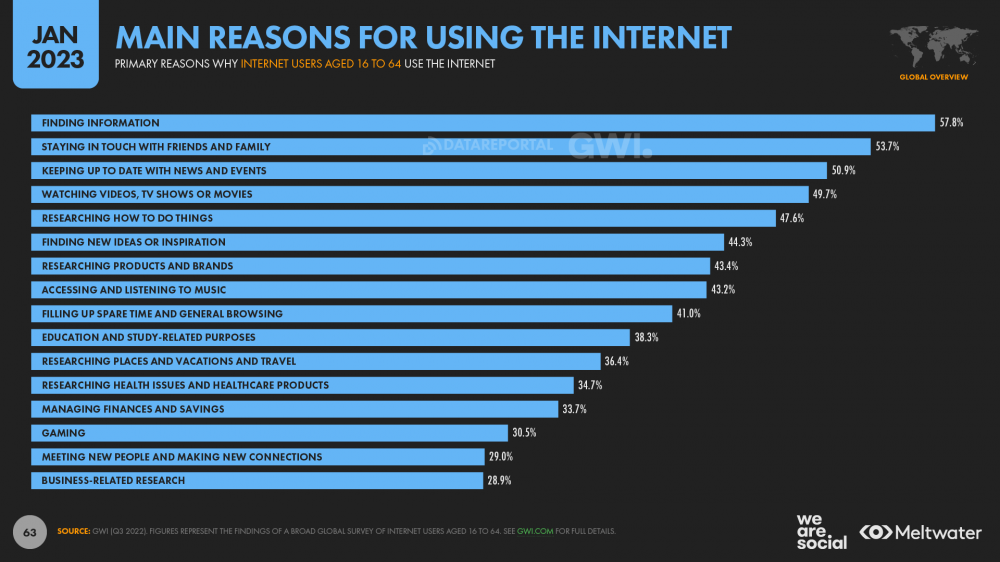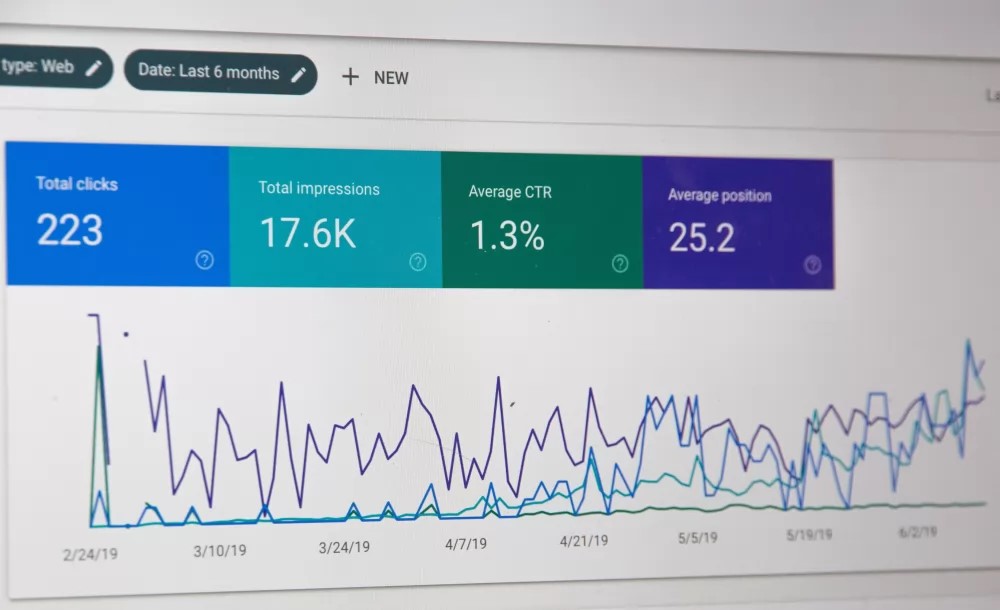As business processes and strategies keep evolving, the need for publicity and exposure to get products and services in front of the audience has remained unchanged.
The processes, however, have evolved. At the moment, online visibility and organic traffic are the key ways not only to thrive, but also “survive.”

The above graph by Dataportal shows that 43.4% of internet users aged 16-64 use the internet to research products and brands. With this, it’s clear that not having a solid online presence sets your business up for failure.
This knowledge has caused fierce competition in online marketing, making search engine optimization (SEO) a key aspect of every marketing campaign. SEO consists of strategies and techniques for improving websites to be more visible and to rank high on search engine results pages (SERPs).
Like everything else, the SEO landscape is constantly evolving, and at the moment, backlinks are a major part of every effective SEO strategy. Understanding the impact of backlinks on SEO and how it works is essential to improve your search rankings and attract a wider audience.
Hence, in this comprehensive guide, we will delve into the world of backlinks, exploring their importance, types, strategies, and best practices to help you build a high-quality backlink profile.
What Are Backlinks?
Also known as inbound links or incoming links, backlinks are hyperlinks that originate from one website and point to another. They serve as a way for users to navigate between different web pages. From an SEO perspective, backlinks are essential because they act as a vote of confidence from other websites, indicating that your content is valuable and worth referencing.
Search engines, particularly Google, assess the quantity and quality of backlinks to evaluate a website’s credibility and popularity. If your website has many backlinks from good/relevant sources, it’ll rank higher in search results and consequently receive more organic traffic. This is because the algorithm will perceive it as a trustworthy and valuable resource.
It’s important to bolster the “good/relevant sources” discussed above. The concept will be flawed if Google’s algorithm ranks every website with many backlinks as authoritative. Many webmasters will try to outsmart the system.
This leads into the next session of the article, where we discuss the different types of backlinks and how Google’s algorithm distinguishes and ranks websites.
Good vs. Bad Backlinks

Image: Pixabay
Good backlinks refer to high-quality and relevant links that come from reputable sources. These backlinks are earned naturally, indicating that other websites view your content as valuable and authoritative. Such backlinks improve your website’s credibility, authority, and search engine rankings.
On the other hand, bad backlinks are low-quality or irrelevant links that can harm your website’s SEO. These backlinks may come from spammy or low-authority websites, link farms, or unrelated sources. They can lead to penalties from search engines and diminish your website’s reputation.
It is essential to focus on acquiring good backlinks through ethical link-building strategies to enhance your SEO performance and avoid the harmful effects of bad backlinks. Some of these strategies are discussed below.
Strategies for Building and Acquiring High-Quality Backlinks
Whether you’re looking to build an effective backlink profile from scratch or review your strategies, the following remain among the most effective ways to earn/build organic backlinks that search engines will approve as authoritative.
1. Creating Resourceful and Informative Content is a fundamental link-building strategy. When your content is good, engaging, and relevant to your target audience, it’ll naturally garner attention over time, and others will be prompted to link to it. To achieve this, you must conduct thorough research, understand your audience’s needs, and deliver content that answers their questions or addresses their pain points.
2. Guest Blogging and Influencer Outreach: When collaborating with influencers or other websites, you can contribute valuable content on their platforms. When doing this, you’ll often get the opportunity to self-promote, which could be by incorporating backlinks in your author bio or within your article. This approach helps you build meaningful connections and relationships and enables you to earn backlinks from trusted sources and attract new audiences to your website.
3. Leveraging Social Media Platforms: By strategically sharing your valuable content across social media platforms and actively engaging with your audience, you significantly increase the likelihood of others discovering and referencing your content in their posts or articles. Social media platforms serve as powerful channels for content distribution, enabling you to amplify your message and attract authoritative backlinks from engaged users and influential figures.
4. Repurposing Broken Links: This involves identifying broken links or links to outdated content on authoritative websites and offering replacement content. You do this by contacting website owners and notifying them about broken links on their sites. In return, you suggest your relevant content as a replacement. This strategy benefits both parties if the owner decides to update the broken link; you earn high-quality backlinks, and they keep their content updated and informative.
5. Providing Expert Opinion and Networking: It’s important to provide valuable contributions or offer expert opinions whenever you can. Also, engage with website owners and bloggers and participate in networking events, social media interactions, and industry forums. This will increase your likelihood of acquiring backlinks through collaborations, mentions, or recommendations.
Monitoring and Evaluating Backlink Performance
More than just building backlinks, it’s important to assess the impact and effectiveness of your backlinks regularly. This will help you identify areas for improvement, websites/backlinks to discard, and websites to focus on.
Monitoring involves tracking key metrics such as the number of backlinks, their quality, referral traffic, and search engine rankings.
To effectively monitor and evaluate your backlink performance, consider the following:
- Use reliable backlink tracking tools like Eye10, Ahrefs, or Moz.
- Analyze website traffic and referral sources to identify top-performing backlinks.
- Assess link quality based on referring domains’ authority, relevance, and diversity.
- Review and disavow any harmful or spammy links.
- Analyze competitor backlink profiles for new opportunities.
- Continuously optimize your strategy based on performance analysis.
By implementing these steps, you can gain insights, improve your link-building efforts, and enhance your overall SEO strategy.
Understanding The Two Primary Types Of Backlinks
Backlinks come in two important types called do-follow and no-follow, each having its place in the interaction of SEO and search engine algorithms like Google’s SERPs indexes.
Do-follow backlinks express website relevancy and authority to search engines by carrying “link juice,” which can boost SEO rankings naturally over time.
In contrast, no-follow backlinks ask search engines not to crawl specific content or follow certain links when indexing sites – they still add value by generating visibility through traffic.
The key is to have a healthy mix of do-follow and no-follow backlinks in your link profile, as it appears more natural and beneficial for your SEO efforts.
Tips For Building Effective Backlinks
A successful strategy for acquiring quality backlinks involves diversifying sources while focusing on high-quality placements, such as authoritative websites with authoritative content relevant to your website.
These key points summarize best practices for building an effective strategy:
- Quality over Quantity: Prioritize acquiring high-quality backlinks from authoritative and relevant websites.
- Relevant and Valuable Content: Create exceptional content that naturally attracts backlinks from others.
- Natural Link Profile: Aim for a diverse and organic link profile with a mix of do-follow and no-follow links.
- Guest Blogging: Contribute guest posts to reputable websites in your industry, and try to include backlinks to your website within the articles organically.
- Influencer Outreach: Collaborate with influencers and industry experts to gain exposure and earn backlinks.
- Social Media Promotion: Leverage social media platforms to share your content and attract backlinks.
- Monitor and Disavow: Regularly monitor your backlink profile and disavow any harmful or low-quality links.
Rounding Up
We have explored backlinks and how they play a crucial role in SEO by impacting website visibility and search engine rankings. We also discussed strategies and best practices for building a high-quality backlink profile.
By applying the information in this guide to your SEO strategy, you can effectively capitalize on the power and benefits of backlinks to improve your business.
